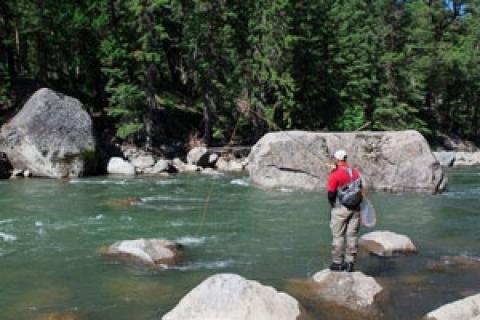
Handling rough water can be a challenge for even the experienced fly anglers. Water speed and currents can be very difficult to judge and even more difficult to manage with a floating line. Trout can be very selective feeders in rough water conditions, so getting a drag free drift on your presentation is a must. Understanding how casting distance, line color and high sticking can effect you presentation will definitely translate into more hook ups for you.
1. Don't Cast Farther Than You Need To
Although fly casting is usually what attracts people to fly fishing, in rough water conditions you need to be mindful of how much line you have spread across the water. The bottom line here is the more line you have out, the harder it is going to be for you to control the line and the drift of your fly. With rough water, fish have a tendency to be less spooky because of the stirred up water and low visibility so getting close won't be an issue for your target.
2. Line Color Key to Locating
I know many fly fisherman feel very different about colors of fly line, but personally I don't have any apprehensions about using fluorescent colored lines — actually I prefer them. In rough water conditions every advantage that you can have in picking up your line on the water, the better. The faster you find your line, the faster you can start the mending process and the faster you can get your fly drifting as natural as possible. I try and stay with the fluorescent greens and oranges because they seem to show up in best rough water and in low light conditions.
3. High Sticking for Drag-Free Drift
The term high sticking is one we use with nymphing techniques to get a drag free drift on flies. In rough water conditions, high sticking (the process of holding the rod high above your head and keeping the line taught and off the water) can be one of the only ways to get a long drag free drift. Fly anglers can use this technique with nymphs, streamers and dry flies by casting upstream/across from their target and lifting the line off the water as soon as the fly lands. The secret here is with the line off the water there is hardly any drag on the leader so the fly is able to sink and drift naturally, making it easy prey in these ambush-feeding conditions.
Mastering a few of these techniques to manage your line in rough water can transform fast, rough water fly fishing from frustration into a fun, rewarding experience. Take time to practice these techniques in a variety of conditions, and you won't be disappointed. The fish will like your more natural fly presentation and reward you with a fabulous day of fishing.
- 4103 views

